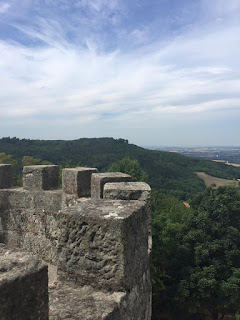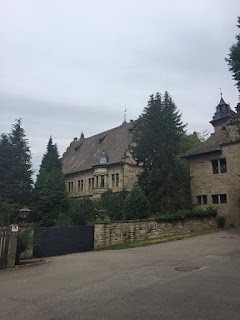Waldenburg Castle lies on the outskirts of Waldenburg on a mountain spur, which extends over the Hohenloher level rises. The partly as a Renaissance chateau executed building is owned by the house of Hohenlohe-Waldenburg-Schillingsfürst.
History
The Waldenburg region was in 1250 a fief of the noble Hohenlohe. A first written mention of a castle is noted for the year 1253rd The city rights were Waldenburg already awarded 1330th The conversion to the castle took place in the 16th century, parts of the changes in the 18th century were undone. Head for one of the Hohenlohe-lines, the building was 1553. The donjon, also referred to as Männle storm, received its present form in 1576. In the early 17th century were more structural changes, where Heinrich Schickhardt acted as advisor, performed. The castle was abandoned in 1679 because the line Hohenlohe-Waldenburg became extinct. The Castle Church St. Michael was built by Christian Stukkateurmeister Dornacher in 1781 and 1782nd In the 19th century the castle was by a inheritance extensively renovated newly created line Hohenlohe-Waldenburg. The castle fell, as well as nearly 80 percent of the total urban area in 1945 by shelling the flames. From 1948 to 1963 took place the reconstruction.
Waldburger Fastnacht
On February 7, 1570 had Earl Eberhard von Hohenlohe-Waldenburg and his wife, Countess Agathe von Tübingen invited aristocratic friends and relatives to be, among other the brother of the Countess, George III. of Tübingen, the nephew Count Albrecht von Hohenlohe-Neuenstein, Valentin von Berlichingen, Kunz of Vellberg and Simon of Neudeck. Possibly inspired by the customs of the area, one was hit on the idea to dress up, even though three years earlier a national order had been issued that forbade the carnival: The women dressed up as angels and men as devils. At the festival, a fire broke out, which was triggered by a costume that caught fire. Several visitors came as a result of the disaster killed, many were seriously injured. What happened, portrays Hofprediger Apin in an authentic contemporary report:
"Anno 1570, 7 February is hergegangen foul to Waldenburg; has gone an infuriating case since the vexing Satan from God Verhangnus has done a schröckliche tragedies and Spectacul, and as a recharger Schadenfroh be Mutlein by lust cooled: why should we paint him nit through the door, invite even a guest, because he cometh probably by himself, or where it is equal to itself nit get there, because he sends out his messengers.
At that time, to Waldenburg in the Shrove Tuesday, in addition to the counts and in addition to those of the nobility together nine countesses whose several masked with Einern English beautiful Habit, therefore, went to even white clothes with white a cardboard wings, as it is usually the angels to paint, and wore on their heads white papierne crowns, therein small wax Lichtlein were burning and shining: on the other hand, the gentlemen and the nobility with a nasty habit masked, were on their pants and Wammes, arm and legs, thick sew tow of flax strong with thread and tie, that they were in zotticht and ragged, as it is usually the Cacodaemones and black Höllhund to paint.
By now, after held dance at night while around 10 impact uf the upper room at the light kneeling bring together a Mummtanz, and not fürsichtig deal with the light, when ye depart from burning gout the tow unawares at: soon there will be a on the hall great tumult and baking, a big fright, cries and lamentations: Kunz of Vellberg are soon to escape, and thus disguised, he jumps a worm that he comes unscathed, and is infected nit from the others, but Valtellina von Berlichingen and Simon of Neudeck, Count Albert von Hohenlohe (Neuenstein) burn so hard that they need a few weeks to stay in bed. Count Georg von Tübingen empfaht supper 22 February.
Afterwards (March 5), the Sontag was Laetare, (because suddenly one another and new random beaten him to fire), dies at 8 clock in the morning and afterwards the 7th hujus with his consort great suffering, pain and lamentation, buried to Oehringen in the collegiate churches since then I have done him a funeral sermon, which I afterwards his wife's mother sent to her desire May 22 with my GH Easy Sermon into gene Lichteneck, however her graces me the following 24 July has the Buben Hofen can deliver him: a silver cup with a lid on their coat of arms of Tübingen has been gouged out. My gn. Lord, Count Eberhard, burned so hard that he afterwards the 21 and 22 February all the fingers on beeden hands had cut lying outside, but received before the 29th (which was then Sunday Reminiscere) the Rev. Supper, even did a beautiful Christian Bekanntnus, because I had a special union favor. Afterwards the 9th Marti, four days after his master's brother-Graf Georgen farewell, dies in females Stuben 10 strike this morning in my Beiwesen, is buried the day 11 hujus to Oehringen in the collegiate churches in addition to his wife's mother and next Count Georgen christian blessed Gedächtnus because I then did him a light sermon. 14 Marti sat Count Albrecht go home again after Neuenstein, and rise again with advice and Hülf his wife mother.
In the fire Veltin the Count Albert von Hohenlohe, Eberhard von Waldburg and Georg of Tübingen came from Berlichingen and Simon of Neudeck, lost their lives.
Buildings
The castle was constructed externally extent possible according to historical appearance. Parts of the building are in the Renaissance style, while the castle church already classicist contains elements. The interiors were no longer true to the original, but also simplifies rebuilt.
Seal Museum
On the ground floor of the Castle Museum is a seal since 1972 established. The collection dates back to the 19th century and was founded by Prince Karl zu Hohenlohe-Waldenburg. This is one of the founding fathers of sigillography. In the exhibited seals there are reproductions, of which have either themselves have an old age.
Castle Administration:
County Zwickau
Waldenburg Castle
Peniger Straße 10
08396 Waldenburg
Contact:
E-mail: ralph.zenker@landkreis-zwickau.de
Phone: (0375) 440227131 or 440 227 123
Contact Tourist Office Waldenburg:
E-mail: tourismus-kultur@waldenburg.de
Phone:
(037 608) 21000 or (0375) 440 227 045
Opening times:
Waldenburg Castle / tourism department of the city Waldenburg
Tuesday to Friday: 10:00 to 16:00 clock
Saturday / Sunday 13:00 until 17:00 clock
The tourism department of the city Waldenburg is located in the main building of Schloss Waldenburg and supervised the tourist lock operation (sightseeing / tours).
Guided castle tours are possible during opening times without prior notification. Castle tours without accompanying personnel are not possible.
Castle tours (duration about 1.5 hours; only after registration) are available year round at the desired time possible.
Registrations accepts the tourism department of the city of Waldenburg.
Naturalienkabinett and City Museum
Naturalienkabinett Waldenburg
Siblings Scholl Platz 1
08396 Waldenburg
037608.22519
www.museum-waldenburg.de
A cabinet full of rarities:
Astronomical and Physical equipment | fish, reptile and amphibian collection | Spiritus preparations bird collection | coral | Insects Conchilien | Hunting trophies | Deformed calves | herbaria | Wood Collection Fossils | minerals and rocks Ethnography | Egyptian mummies | Art + Craft

























































